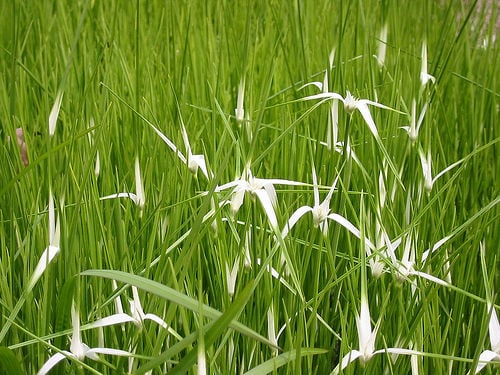Solve Drainage Problems With a Rain Garden
A rain garden is a beautiful solution to drainage problems on your property from stormwater runoff and other sources.
A single inch of rain falling on a roof or other impervious surface
produces 680 gallons of stormwater runoff per 1000 square feet. All too often, this water contributes to erosion or drainage problems on land, or carries pollutants into surface or groundwater supplies. an estimated 70% of water pollution in developed countries is caused by stormwater runoff from roofs, roads, and similar surfaces.
Rain gardens are shallow, bowl-shaped depressions planted heavily with flowers, ornamental grasses, sedges, and other plants. Rain gardens collect runoff from gutters and roofs, decks, roads, and other impervious surfaces and allow it to infiltrate naturally into the soil and be absorbed by the plants, instead of contributing to drainage or erosion problems on your property. Rain gardens also help prevent ground and surface water pollution from polluted stormwater by taking up pollutants into the plants, and decrease the risk of flooding by reducing the amount of runoff channeled into nearby rivers, streams, and creeks.

Planning Your Rain Garden
The best spot to plant your rain garden is an area where water already collects after storms.
However, rain gardens should not be located too close to the foundations of your home or other buildings on your property. Ideally, the rain garden should be at least 10 feet away, and downslope from the foundation. If you have a septic system, avoid locating your rain garden in the drainfield.
If your low spots are located too near your home, construct channels or swales to direct the water to a more desirable location. You can also install a rain barrel to collect water from gutters, and direct the overflow hose to empty into your rain garden.
If you have multiple low spots, choose one or two near downspouts from your roof or paved surfaces such as the driveway or road.

Native Plants
- Native Plants of the United States
Provide habitat for wildlife and create a beautiful, low maintenance landscape with hardy native plants. This lens offers information and resources about native plant gardening in all major regions of the United States.
Planting Your Rain Garden
When you've chosen a spot, you can begin excavating the rain garden. You will need to dig a saucer or bowl shaped depression with a deeper depression in the middle. For most rain gardens, the deepest area should be about six inches. If you have extremely poor drainage, make the whole garden larger and shallower to prevent water getting trapped for too long and creating habitat for mosquitoes. You can also improve drainage in extremely poor soils by digging deeper and replacing some of the excavated soil with a mix of about 1/2 sand, 1/4 topsoil, and 1/4 compost.
When the garden is excavated, you can begin planting.
Native plants are the best choices for rain gardens, because they are best adapted to local conditions. Many native plants also have deep roots that help break up heavy or compacted soils and improve drainage. Finally, native plants also attract butterflies, birds, and other wildlife, making the garden even more beautiful and colorful.
Choose plants for the deepest area in the center that will tolerate wet conditions, and for the edges choose plants that will tolerate a mix of wet and dry conditions.
After planting, mulch the area with two to three inches of wood chips or other organic mulch.
Rain Gardens
Learn More
- Rain Gardens of West Michigan
Rain Gardens of West Michigan is an environmental education program focused on stormwater education, and on the values of using rain gardens and native plants in the landscape to improve urban and suburban water quality. - Rain Garden Network
Rain Garden Network offers planning tools, installation services and education & outreach materials & services to homeowners, organizations and municipalities - Rain Gardens: A How-To Manual for Homeowners (PDF)










